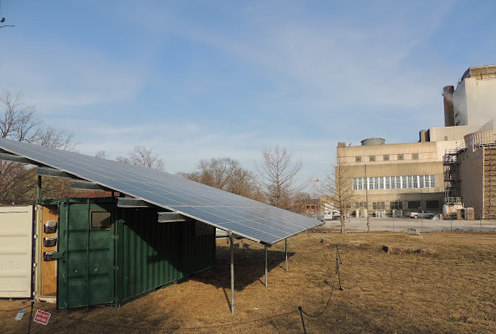SunCrate providing mobile power

MICHAEL CRUMB Mar 10, 2021 | 10:17 pm
3 min read time
755 wordsAll Latest News, Energy, Statewide NewsA SunCrate, developed with help from a grant from the Iowa Energy Office, is set up in Ames to test its solar energy collection and distribution capabilities. Photo by Michael Crumb
A Sioux City-based company is harnessing the power of the sun and using portable storage units that can provide power to homes and businesses when a natural disaster strikes, or to supplement the current energy supply when electrical loads are high.
SunCrate was founded by Dolf Ivener after he started thinking about putting solar energy systems on hog confinements. Because of changes made by rural electric cooperatives in how the confinements were metered, he started to look into how to use batteries with the solar energy system. What he came up with was a shipping container with a battery and solar panels inside that can be deployed in a short period of time.
“It’s basically a mobile power station we can deliver and drop off,” Ivener said. “In the power station you have solar, you have battery and you have a generator. You basically have a hybrid nano grid.”
The mobile unit, a 20-foot shipping container, is designed with charging outlets on the outside for people to plug in their phones, electric cars and other items they may need during a catastrophic event. The crate can even provide energy for heating or cooling care facilities such as hospitals as well as other community facilities.
SunCrate has been in development for five to six years, Ivener said, and the biggest challenge was finding the right battery. He’s used batteries made by LG, Samsung, a battery from a Nissan Leaf electric car and others, including Tesla.
“I’ve pretty much settled on Tesla, so we’ve got a Tesla battery, a bunch of solar panels, and the Tesla battery talks to the generator,” Ivener said.
SunCrate received a $180,800 grant from the Iowa Energy Office and it partnered with the Iowa National Guard to develop it the unit with the help of Iowa State University. The grant was funded by the U.S. Department of Energy.
Ryan Young, project manager at the Iowa Energy Office, said SunCrate fits with work being done by the Iowa Energy Office because of its resiliency, storage mobility.
“It kind of hit all those buttons for us and was definitely something we wanted to get involved with,” Young said.
He said it’s believed SunCrate has the potential for widespread development.
“With the storms that have happened and everything going on down in Texas, it has started a lot of those conversations about what is the true potential for this type of resource,” Young said,
The cost of a SunCrate unit starts at about $40,000 with storage ranging from 26 kilowatt hours to 250 kilowatt hours.
A test unit is set up near Bandshell Park in Ames, adjacent to the city’s power plant, where it’s being used to charge electric vehicles, Ivener said.
But the goal is to do a lot more than that.
Ivener said the average house in the U.S. uses about 30 kilowatts a day. SunCrate could provide seven to eight days of backup power for that home, he said.
Ivener said he sees SunCrate’s applications ranging from everyday use when the electric load is high to providing emergency power during natural disasters, like last summer’s derecho or the power outages seen during the recent winter storms in Texas.
The project is in its second phase of development, which involves identifying more places to place SunCrate to test in various situations.
“What you don’t want is the box just sitting there not plugged in; that defeats the purpose,” Ivener said. “It can be plugged into grid stability and produce power and all those things, and in case of a natural disaster you can pick up and move it quite quickly.”
SunCrate is located in a 15,000-square-foot warehouse in Sioux City, which would allow it to ramp up production quickly if demand increases, Ivener said.
He believes the best locations for its use are in the southern U.S. where less electricity is used to heat homes and businesses.
Two years ago he took a SunCrate to Puerto Rico after Hurricane Maria devastated the country, and he donated it to a school, Ivener said.
“It’s been working flawlessly for 2½ years,” he said.
He sees similar applications to provide stable electricity in the U.S.
“We’re trying to move the needle,” he said. “It’s trying to get reliable, renewable power to people.”
Editor’s note: This story has been updated with the correct spelling on SunCrate.











